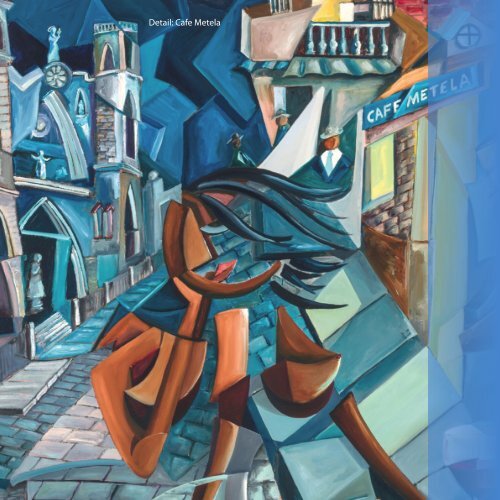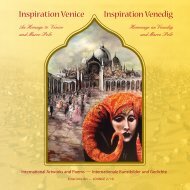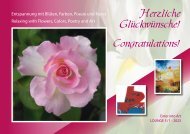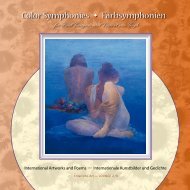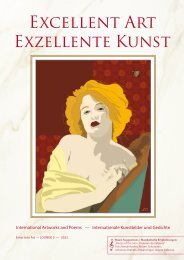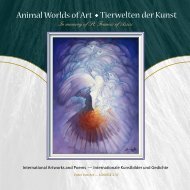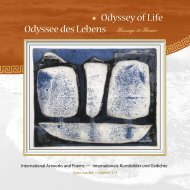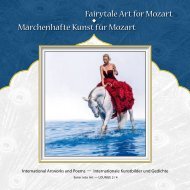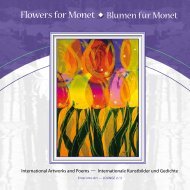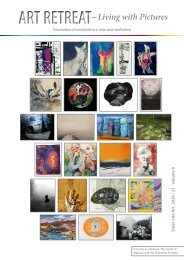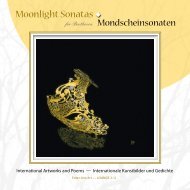Derwin Leiva - Cubism from Hawaii
Fiery sunsets, glowing lava rocks, and white sand beaches – that’s Hawai’i. Flowers bloom in radiant colors against the ocean’s blue. On his way to Cuba, Alexander von Humboldt analyzed the hues of the sky over exotic islands using a color scale, and found major differences compared to German skies. Inspired by this vibrant richness, in this solo book, the Cuban born artist Derwin Leiva presents a polychrome selection of paintings. Leiva pursued a bachelor’s degree in art with a focus on sculpture at the University of Hawai’i at Manoa. Since 2004, he has made Honolulu his home - the place where he lives and works. After growing up in the cultural environment of Caribbean cities, the artist now creates large oil paintings emanating a nostalgic melancholy. While the colorful temptations of Hawaiian folklore are also reflected in them, his Cubist-influenced paintings are dominated by voices of homesickness, wanderlust, and indeterminate longing. The printed book is available from bookseller Peecho in Amsterdam: https://www.peecho.com/checkout/162187384649059167/1298717/derwin-leiva-cubism-from-hawai-i-kubismus-aus-hawaii (Das gedruckte Buch ist beim Buchhändler Peecho in Amsterdam erhältlich.) Glühende Sonnenuntergänge, brodelndes Lavagestein und puderweiße Strände – das ist Hawai’i. Dazu schillert zum Blau des Meeres eine farbenreiche Blütenpracht. Alexander von Humboldt analysierte auf dem Weg nach Kuba das Himmelsblau exotischer Inselwelten anhand einer Farbskala und stellte starke Unterschiede zu deutschen Breitengraden fest. Angeregt von diesem Farbtriumph stellt der gebürtige Kubaner Derwin Leiva in seinem Solobuch eine polychrome Bildauswahl vor. Leiva erlangte an der University of Hawai’i Manoa einen Bachelor-Abschluss im Fach Kunst mit Schwerpunkt Bildhauerei. Seit 2004 hat er Honolulu zu seiner Heimat gemacht – dem Ort, wo er lebt und arbeitet. In den großformatigen Ölgemälden des im kulturellen Umfeld alter karibischer Städte aufgewachsenen Malers begegnet man einer nostalgischen Melancholie. Zwar spiegeln sich auch die farbenfroh-folkloristischen Verlockungen Hawai’is darin wider, begreiflicherweise dringen aus den kubistisch beeinflussten Bildern jedoch Töne von Heimweh, Fernweh und einer unbestimmbaren Sehnsucht.
Fiery sunsets, glowing lava rocks, and white sand beaches – that’s Hawai’i. Flowers bloom in radiant colors against the ocean’s blue. On his way to Cuba, Alexander von Humboldt analyzed the hues of the sky over exotic islands using a color scale, and found major differences compared to German skies. Inspired by this vibrant richness, in this solo book, the Cuban born artist Derwin Leiva presents a polychrome selection of paintings. Leiva pursued a bachelor’s degree in art with a focus on sculpture at the University of Hawai’i at Manoa. Since 2004, he has made Honolulu his home - the place where he lives and works. After growing up in the cultural environment of Caribbean cities, the artist now creates large oil paintings emanating a nostalgic melancholy. While the colorful temptations of Hawaiian folklore are also reflected in them, his Cubist-influenced paintings are dominated by voices of homesickness, wanderlust, and indeterminate longing.
The printed book is available from bookseller Peecho in Amsterdam:
https://www.peecho.com/checkout/162187384649059167/1298717/derwin-leiva-cubism-from-hawai-i-kubismus-aus-hawaii
(Das gedruckte Buch ist beim Buchhändler Peecho in Amsterdam erhältlich.)
Glühende Sonnenuntergänge, brodelndes Lavagestein und puderweiße Strände – das ist Hawai’i. Dazu schillert zum Blau des Meeres eine farbenreiche Blütenpracht. Alexander von Humboldt analysierte auf dem Weg nach Kuba das Himmelsblau exotischer Inselwelten anhand einer Farbskala und stellte starke Unterschiede zu deutschen Breitengraden fest. Angeregt von diesem Farbtriumph stellt der gebürtige Kubaner Derwin Leiva in seinem Solobuch eine polychrome Bildauswahl vor. Leiva erlangte an der University of Hawai’i Manoa einen Bachelor-Abschluss im Fach Kunst mit Schwerpunkt Bildhauerei. Seit 2004 hat er Honolulu zu seiner Heimat gemacht – dem Ort, wo er lebt und arbeitet. In den großformatigen Ölgemälden des im kulturellen Umfeld alter karibischer Städte aufgewachsenen Malers begegnet man einer nostalgischen Melancholie. Zwar spiegeln sich auch die farbenfroh-folkloristischen Verlockungen Hawai’is darin wider, begreiflicherweise dringen aus den kubistisch beeinflussten Bildern jedoch Töne von Heimweh, Fernweh und einer unbestimmbaren Sehnsucht.
You also want an ePaper? Increase the reach of your titles
YUMPU automatically turns print PDFs into web optimized ePapers that Google loves.
Detail: Cafe Metela<br />
Timbres of Wanderlust<br />
<strong>Cubism</strong> in Hawai’i? Wasn’t <strong>Cubism</strong> mostly associated<br />
with Paris, Picasso, Braque, and the French-German<br />
gallerist Kahnweiler? Yet <strong>Derwin</strong> <strong>Leiva</strong> found a<br />
natural affinity for painting in the Neo-Cubist style,<br />
particularly after being raised in Cuba, a rebellious<br />
island that once aimed to foster a unique kind of<br />
humanity, liberated <strong>from</strong> materialistic pursuits,<br />
and instead enriched by inner wealth. Columbus, on<br />
the other hand, hoped to find as much gold as possible<br />
there. Back then, only a few thousand native<br />
islanders survived. Later, within the short span of a<br />
hundred years, three quarters of a million Africans<br />
were brought to Cuba to toil on the sugar plantations.<br />
Besides their plaintive ballads, they also<br />
brought their sophisticated drumming rhythms and<br />
the odd fetish to the Caribbean. Havana became a<br />
major maritime trading hub with Latin America.<br />
Hawai’i, too, which became the fiftieth of the United<br />
States in 1959, is a melting pot of different peoples<br />
and cultures.<br />
As opposed to Picasso, <strong>Derwin</strong> <strong>Leiva</strong> has no<br />
need to visit anthropology museums. His personal<br />
history gives him all he needs to bring together<br />
the natural appeal and poetic immediacy of Latin<br />
America, African and Oceanic, as well as European<br />
art and culture. Through their brilliantly simplified<br />
shapes and sophisticated colors, the fetishes of<br />
indigenous peoples have long been a source of inspiration<br />
to modern artists (also see Wilfredo Lam,<br />
one of <strong>Leiva</strong>’s personal favorites). Today, the powerful<br />
expressiveness of art’s “primitive” beginnings is<br />
widely recognized. With their orgiastic shape and<br />
color compositions, they are in no way inferior to<br />
the “advanced civilizations” of today. We only need<br />
to look at hula dancers with their flower wreaths,<br />
chants, and grass skirts. <strong>Derwin</strong> <strong>Leiva</strong>’s art may also<br />
have been influenced by the colorful unique feather<br />
coats of former island kings. Indeed, his vibrant<br />
paintings are remindful of flamboyant ritual dances,<br />
the strongly stylized faces of his protagonists<br />
resemble masks. A hinted halfmoon stirs up associations<br />
of sun and moon mythology.<br />
Not only the culture but also the poetic-sounding<br />
language of the native <strong>Hawaii</strong>ans, who originally<br />
came <strong>from</strong> Polynesia, resembles the tongues<br />
of other South Sea islands. While it has 33 words<br />
for “clouds”, there is not a single one for “windless”<br />
– the music of the surf, the rippling waterfalls, the<br />
trade winds, and the heavy storms never cease. It<br />
is against this background that <strong>Derwin</strong> <strong>Leiva</strong> brings<br />
the dazzling colors and powerful music of Cuba and<br />
Hawai’i to his large oil paintings, and in this context<br />
that the editor contributes her haiku poetry. The<br />
artist's imagination was sparked by the sight of colibris<br />
frantically flapping their wings to find nectar<br />
amidst a plethora of flowers, by captivating coral<br />
reefs and colorful parrots, by the scent of tobacco,<br />
and by Cuba’s traditional folk dances and music, all<br />
of which stood out against its fading ideology.<br />
With the romantic architecture of his nostalgic<br />
places, the artist draws observers right into his<br />
images, appealing to all their senses at once. Picturesque<br />
colonnades, shady arcades, bumpy cobble<br />
stone roads, old tiled roofs and quaint wooden<br />
shutters, wrought-iron balconies and ornamental<br />
lattices, as well as walls in bright colors and playfully<br />
decorated homes tell us stories <strong>from</strong> the past<br />
two centuries of Latin American cities. Sometimes<br />
containing social commentary, the paintings bring<br />
together antiquated objects of daily life with quaint<br />
interiors painted in a Caribbean-influenced <strong>Hawaii</strong>an<br />
Neo-Cubist style. Through the visual swirl<br />
of colors and intentionally bent shapes, the artist<br />
makes his paintings dance. Observers can virtually<br />
feel his heart beating for the type of music known<br />
<strong>from</strong> Buena Vista Social Club, the classic Son Cubano,<br />
which, influenced by swing and jazz, brings<br />
together elements of both black and white music.<br />
At the same time, we can also hear the soft strumming<br />
of <strong>Hawaii</strong>an guitars. Sound and rhythm are<br />
the heartbeat that makes <strong>Derwin</strong> <strong>Leiva</strong>’s paintings<br />
come alive.<br />
Music-making is also featured in his works<br />
through the direct depiction of musicians and musical<br />
instruments, juxtaposed with lively old alleys.<br />
Multiple different shades of blue add to the music<br />
playing tones of sea and sky. Technically speaking,<br />
it is striking how contrasts in shape and color are<br />
brought together, while combining traditional<br />
techniques with elements of <strong>Cubism</strong> (breaking<br />
down objects, geometric, edgy, acute-angled and<br />
tube-like shapes), which makes <strong>Leiva</strong>’s original<br />
painting style the real object of his art. With his stereotyped<br />
dynamics of shapes and colors, the artist<br />
has created his very own highly unique and unmistakable<br />
style.<br />
4 5


